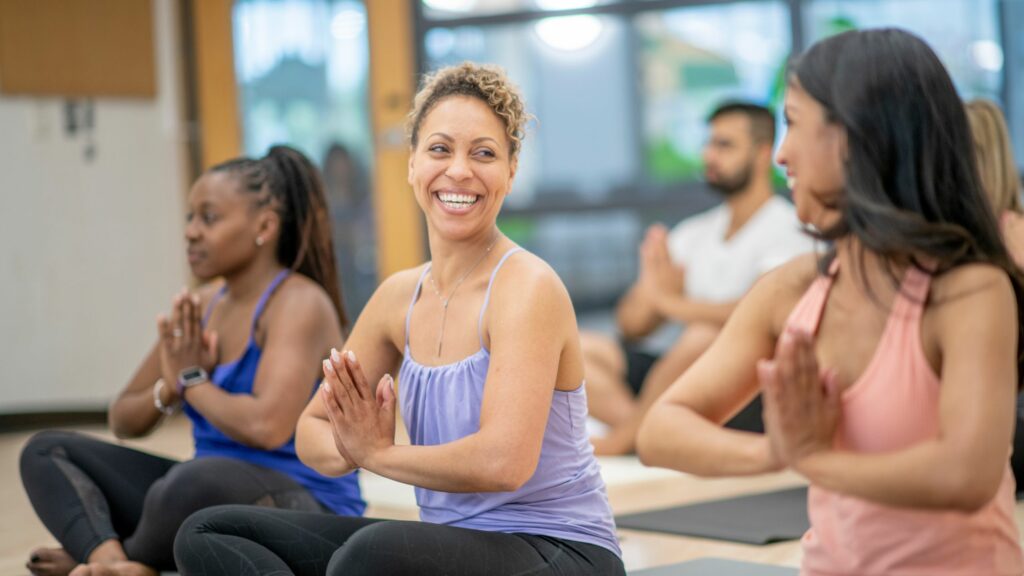
Is Yoga Enough for A Midlife Woman’s Stress?
Why are women in midlife so stressed? I bet you think I’m going to say menopause. Or Hormones. Am i right?
Wrong. For once, the answer isn’t hormones.
Why DO midlife women have stress?

People say adolescence is tough. But midlife is when spit really hits the fan for women. Here are the real reasons we’re so stressed:
- Increased responsibilities at work.
- Relationships breaking down.
- New Relationships.
- Blended Families.
- Launching kids.
- Serious health diagnoses.
- Financial insecurity.
- Caring for aging parents.
These were all reasons given by women participating in a 23-year study about what causes stress in middle age.
Only four of 81 women mentioned menopause as a challenge.
The study concluded:
“Women found themselves searching for balance in the midst of multiple co-occurring stressors while coping with losses and transitions, for some in a context of limited resources.”
Basically, we’re juggling too many things with not enough arms.
What’s the result of all this stress?

Chronic stress weakens your immune system.
Your body copes with stress by releasing epinephrine and cortisol. When these hormones are present all the time, plaque builds up on your artery walls putting you at greater risk of stroke.
When your body is constantly in survival mode, it never gets a chance to look after basic upkeep.
So does Menopause cause stress?
No.
Menopause doesn’t cause stress. Stress stops your body from managing menopause.
What?
After menopause, our ovaries stop producing estrogen. When that happens, our adrenal glands are supposed to pick up the slack by producing small amounts of estrogen and progesterone.
Unfortunately, they can’t do this job if they’re busy producing cortisol – the stress hormone.
The adrenal glands have to assume you’re using the stress hormones to run from tigers, which is more important than fertility.
Reduce your stress, and your menopause symptoms are likely to subside.
How does Yoga reduce Midlife Stress?

Yoga is particularly good for the kind of stress middle-aged women experience. I.e. juggling priorities and worries on little sleep.
That’s because yoga gives your body and mind opportunities to practice juggling in a safe environment.
Sensations are temporary (and so is everything else)

Think of a pose you find really hard – say twisted chair pose.
Your thighs and glutes are burning. Your teeth keep clenching. You just want it to be over.
And then…it’s over.
Putting your body through short periods of stress helps you learn that difficulties are temporary.
Focus on breathing calmly, unclench your teeth, and trust that this negative feeling or incident will pass eventually.
Yoga boosts confidence
When your kid/partner/co-worker is sick, do you think:
- My whole day is ruined. Nothing is getting done today.
- This sucks. What’s the best way to manage it?
Either way, you’re dealing with an unexpected obstacle. But the second response feels less stressful.
The more confidence you have in your ability to overcome obstacles, the less they stress you out.
Practicing the Yoga Pose You Hate
Say your yoga teacher asks everyone to do a side plank, and you worry you won’t be able to manage it. You groan. You swear you won’t be able to do it.
And then surprise! You hold it for a few seconds longer than you thought. Or you figure out a way to do it on your elbow or with a leg out as a “kickstand.”
Yes! You proved yourself wrong! You were able to figure out a way to do side plank after all.
And if you were able to figure out side plank, then maybe you’ll be able to get your report done with a sick kid/co-worker/partner after all. Maybe there’s a “kickstand” for that too.
Focus on the present moment

Something that often gets in the way of practicing yoga regularly is worrying that they don’t have the energy or strength to get through the whole class.
But when we decide to focus on the strength or energy we need for one moment at a time, it becomes much easier.
First, we just try to get to the mat with our yoga clothes on and our water bottle ready.
Instead of worrying about the standing poses to come, we focus solely on the warm up.
Every time you catch yourself worrying about the whole class at once, stop. Ask yourself what you need to focus on right now.
Maybe you’ll find that, pose by pose, you did get through the whole class after all.
Maybe you’re really not feeling at your best today and you decide to quit after half an hour.
But for that half-hour you were totally focused on what you were doing.
A totally focused half-hour of warm ups and seated stretches is way more valuable than 30 minutes of going through motions while you pre-planned dinner and worried about the report you didn’t finish. In the second scenario, nothing gets your full attention.
Commit to focusing on the present task in your yoga practice, and I guarantee you’ll get better at focusing on one task at a time in your daily life too.
How to practice Yoga for Midlife Stress
How often and how much?
Two to four times a week would be amazing. But you know what? Once a week is still great.
Don’t make yoga a new thing to stress about.
What kind of yoga is best for midlife stress?
Restorative yoga is great for winding down from a stressful day. Choose this style when you just want to relax.
For long-term stress reduction, I’d recommend a hatha or vinyasa class. These classes train the body to feel stress and then come back to base.
You activate the sympathetic nervous system when you do challenging postures, like standing poses and balances.
Seated and supine postures, like forward fold and revolved belly twist, activate the parasympathetic nervous system.
Need more inspiration?
Join my yoga membership for a library full of practices, and monthly live class together.
Don’t forget Breathwork.

One of the biggest reasons yoga is such a great stress reliever is because of the focus on breath.
Even just paying attention to your breath can be enough to calm your heart rate.
Why?
Because your breath is always happening in the present moment. So if you’re focused on your breath, you’re automatically not thinking about the million other things you have to do today.
Extended exhale
This is the easiest trick there is for switching your body from fight or flight to rest and digest.
Simply make your out breath last a second or two longer than your in breath.
Count, if that helps. See how long it takes to get to the top of your normal inhale. Breathe out for an extra count or two longer.
Use this method when you’re feeling stressed, or when you’re trying to fall asleep.
Meditation is excellent for reducing stress

Think of all your your thoughts and emotions as weather – rain, wind, hail, fog.
Your mind is the sky. Weather patterns come and go, but the sky is constant.
Meditation is a way of looking beyond the weather to the part of your mind that’s constant.
If you never practice meditation, you might fall into a trap of thinking that you are a bundle of anger/anxiety/judgment/sadness. You’re not.
Your mind may be experiencing all those feelings and thoughts. But they are as temporary as weather. No matter how hard the wind blows, the sky never falls.
Is Yoga A Match for MidLife Stress?

The truth is, we have a lot to be stressed about. It’s not just one thing. And that means we can’t just take hormone replacements, or vitamins to fix it. And we can’t cut all the sources of stress out of our lives, because it’s coming from all sides.
That’s why I’d argue that yoga is the best answer. It’s not just physical exercise. It’s a method of training our minds and bodies to be okay with stress.
In effect, yoga upgrades our skills to match our opponent. When we have the confidence that we can handle whatever comes, our stress naturally reduces.
More Yoga for Stress Tips?
Do you need regular motivation to stick to a yoga practice? Join my yoga membership for a mix of live and video classes every month.



